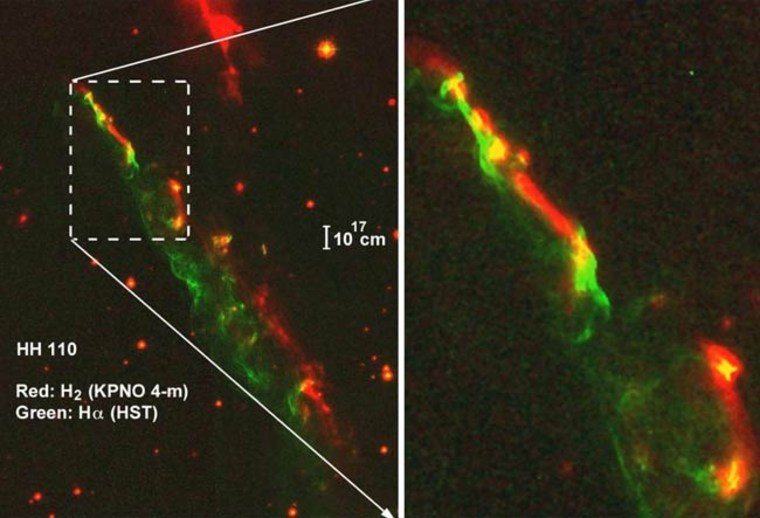Astrophysicists no longer sit and idly wonder what happens when a powerful stellar jet from a young star collides with giant clouds of gas and dust. They first watch what happens hundreds of light years away, and then recreate the cosmic event with a multi-trillion-watt laser capable of delivering more power than exists in the entire U.S. power grid.
A recent experiment did just that with the Omega laser at the University of Rochester in New York, and then compared the lab results with both computer models and telescope observations of a real-life stellar jet. The study marked the first time that astrophysicists have collected new astronomical data from a laboratory simulation.
"Ours is the first study to investigate what happens when jets run into obstacles along their paths, and the first to have a strong enough laser to properly scale the shock waves in a jet to the astrophysical case," said Pat Hartigan, an astrophysicist at Rice University in Houston, Texas, and lead author of the new research.
Huge lasers aimed at tiny targets
Experimental runs went like this: The football field-sized Omega laser would fire for just millionths of a second at a small cylindrical can called a Hohlraum. The vaporized can would send radiation slamming into a piece of titanium the size of a marble, and the titanium almost instantaneously heated into a plasma similar to what exists in stellar jets. The plasma would then strike a tiny sphere of plastic embedded in foam, which stood in for interstellar gas clouds.
"Targets are literally the width of a dime," said Adam Frank, an astrophysicist at the University of Rochester. "And then to hit the things with one of the most powerful lasers and not have it all turn into mush, that's what the target design was really pushing."
Such laser-driven experiments have enabled astrophysicists to simulate phenomena such as supernova blast waves in Earth labs. The Omega laser at the University of Rochester's Laboratory for Laser Energetics represents one of the top three lasers around.
The most powerful lasers have only recently emerged at the National Ignition Facility in California. There physicists hope to carry out "the ultimate lab experiment," in Frank's words, by triggering a thermonuclear fusion reaction similar to what takes place in the sun.
But scientists looking to conduct smaller-scale experiments more than once a day can still flock to the Omega laser and its counterparts.
"The thing about Omega is that it's incredibly flexible," Frank told SPACE.com. "It can fire every hour or so."
Deep impact makes big splatter
Even the most powerful laser experiments still fall short of stellar jets that erupt outward from the poles of newly born stars at hundreds of miles per second. But Hartigan and Frank knew that they could compare the Omega laser experiment to real-life stellar jet collisions because of mathematically equivalent ratios among the matter densities.
In other words, the mathematics of stellar jets doesn't really depend on the vast difference in physical size between a stellar jet and superheated plasma in a lab, or between a gigantic interstellar cloud and a small plastic sphere, Frank explained. The behavior of the two systems will be the same as long as the density ratios are the same.
The real-life comparison for the experiment came in the form of a stellar jet hundreds of light years away, named Herbig Haro 110. Hartigan collected fresh observations about the stellar jet by using a telescope at Kitt Peak National Observatory outside of Tucson, Arizona.
Much of the experiment closely resembles how interstellar clouds and gas clumps can partially deflect stellar jets, but a few differences emerged. The researchers found to their surprise that the experimental jet in the lab burrowed into the plastic sphere and lifted entire pieces off, rather than simply vaporizing the target pieces. That lab finding helped explain observations of how real-life stellar jets could drag along easily-destroyed molecular hydrogen from clouds.
"The new infrared images from Kitt Peak, when compared with existing Hubble Space Telescope images show this phenomenon quite well," Hartigan said. "In our data the red is H2 (hydrogen) and clearly is along one side of the deflected flow, just like what we see in the lab."
Thermostats for star nurseries
The most recent laser experiment replicated what might happen if a stellar jet impacts a giant interstellar cloud, but astrophysicists also want to know about the more common cases when jets run into smaller gaseous clumps.
Frank says that the smaller-scale collisions may explain why stellar jets don't look smooth like a garden hose, but instead appear more fragmented. Stellar jets might also simply emerge in that fragmented state from young stars — and that would touch on the mystery of why young stars consistently create such jets.
Stellar jets could even represent thermostats for stellar nurseries by regulating star birth.
"Clouds that form stars are really pretty inefficient at turning mass into stars," Frank noted. "Maybe something like the feedback from many jets running into each other or their environment keeps the cloud from collapsing on itself [and forming more stars]."
For now, the researchers have scheduled Feb. 26, 2010 as their next big date with the Omega laser.
"We have an ongoing project to study how shock waves [from stellar jets] behave when they pass through clumpy environments, as happens in real astrophysical situations," Hartigan said.
